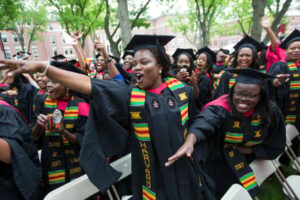
Students Link Trust in College to Affordability

Public trust in higher education has been declining for years. Recent polling data indicated it could be improving, but colleges and universities still have a long way to go in regaining the kind of public support they need now, perhaps more than ever. And too often, conversations about trust—which can help colleges and universities understand where they need to improve—lack a critical perspective: that of students themselves.
About the Survey
Student Voice is an ongoing survey and reporting series that seeks to elevate the student perspective in institutional student success efforts and in broader conversations about college.
Some 1,047 students from 166 two- and four-year institutions, public and private nonprofit, responded to this flash survey about trust in higher education, conducted in July. Explore the data, captured by our survey partner Generation Lab here. The margin of error is +/- 3 percentage points.
Look out for future surveys and reporting from our 2025–26 survey cycle, Student Voice: Amplified.
Findings from a new student survey on trust from Inside Higher Ed and Generation Lab help amplify the student perspective—and hold some good news for higher ed: Students tend to trust their colleges and universities.
But there are concerning signals, as well, such as that a significant share of students who say their trust in higher education has actually declined since they started college. And throughout the survey, students cite affordability as a barrier to trust—underscoring how the cost of attendance, and not just the longer-term value of college, is sowing doubt.
Here’s an overview of the survey results and some ideas as to how institutions might start rebuilding public trust—starting with their students.
Majority of Students Trust Their College
Nearly two in three students (62 percent) express somewhat or very high trust in their institution. Just 11 percent express somewhat or very low trust. The rest are neutral. Community college respondents are especially likely to indicate very high trust, at 24 percent (versus 14 percent of four-year college peers). Students at public institutions are also more likely to express very high confidence than their peers at private nonprofits.
Other differences: Students 25 and older are more likely than their 18- to 24-year-old peers to express very high trust (29 percent versus 14 percent, respectively). By race, Black (19 percent) and Hispanic (26 percent) students express very high confidence at a higher rate than white (14 percent), Asian American and Pacific Islander (13 percent) students, and peers of other races (11 percent). This pushes back on the documented racial trust gap for underrepresented students in higher education. But due to the relatively small sample sizes in this flash poll (Black respondents totaled 106 and Hispanic respondents 168), results must be interpreted with caution and alongside future research.
First-generation college respondents are also less likely than those with a parent with a four-year degree to express somewhat or very high confidence in their institution (57 percent versus 64 percent). Prior research highlights how trust among first-generation students grows when they succeed to become first-generation graduates—demonstrating the value of student success initiatives targeting or inclusive of first-generation students. This may also be evidence that the growing diploma divide among U.S. voters impacts how even enrolled students experience college, and further reason for colleges and universities to reach out to first-generation students as well as their families.
Kevin Fosnacht, director of institutional reporting and analytics at DePauw University, who has researched the racial trust gap and student trust issues extensively, reiterated that trust in all kinds of institutions has been declining for years, and “higher education is not immune.”
At the same time, Fosnacht said, he’s also found that most students trust their own college: “After all, if you distrusted a school, you probably wouldn’t commit significant time and money to it.”
Some students still have negative experiences, as reflected in attrition rates across higher education, he continued, “so a minority reporting decreased trust is understandable and expected in my view.” That is, “if you have to leave the institution through poor grades, due to a lack of support from the institution or other negative experiences, you will likely become distrustful of your college or university.”
One in Three Students Report Losing Trust in Higher Ed Since Starting College
Per Fosnacht’s point about students losing trust during college, a quarter of students (25 percent) say their trust in higher education as an institution—not just their college—has increased, somewhat or significantly, since starting college. The plurality, 39 percent, say it’s stayed the same. But 36 percent say it’s decreased at least somewhat. So, in terms of overall numbers, actually being in college isn’t moving the needle on students’ trust in higher education.
Some notable differences: Adult learners (25-plus) are more likely than younger peers to say their trust has increased significantly. This is consistent with what other research has called a “red flag” for trust in higher ed among Gen Z learners. And paralleling the institutional finding above, community college students are significantly less likely than four-year peers to report that their trust in higher ed has decreased at all during college: 41 percent of four-year students report a decline in trust versus 22 percent of two-year students.
How does this compare to other public trust polling? Gallup and Lumina Foundation have found that Americans express greater confidence in community colleges than in four-year institutions on a variety of metrics, including affordability, quality and the student experience. (More on affordability later.)
Catharine Bond Hill, president emerita of Vassar College—who has written about rebuilding public trust for the nonprofit Ithaka S+R, where she is managing director—noted (rightly) that the survey sample does not include respondents from the vast and growing pool of learners who have started college and stopped out: “Current students don’t think they will join their ranks, but the data suggest many won’t complete.” So, like Fosnacht, she emphasized the importance of efforts to support student success, up to and beyond graduation. These include affordability and career-readiness measures, as well as making sure needed courses and emergency funds are offered.
If I were advising a college president wondering what to make of this, I’d tell them to pair affordability with strong career-pathway programs and invest in faculty development to reinforce the classroom behaviors that matter most to students.”
—Richard Roman, founder of Trusted Arc Labs
As for why trust declines in college for some, Hill pointed to the “great uncertainty about what the labor market is going to look like when current students graduate,” including concerns about the economy and artificial intelligence eliminating jobs. While college still broadly returns on the investment, she said, “it is riskier than it used to be, because families are investing more in many cases.”
Making sure students can acquire “the skills that employers are looking for will be important,” Hill added. “This doesn’t mean moving away from a liberal education and just focusing on these kinds of skills, but schools can do both.” She recommended promoting AI literacy, experiential learning and internships.
Faculty Concern for Students’ Well-Being Builds Trust
A Student Voice survey from 2024 found that students trust faculty members the most, of all campus groups (and presidents and other top administrators the least). This flash survey sought to build on that finding by asking students which faculty behaviors most promote trust in the classroom—similar to what researcher Peter Felten and colleagues call faculty “trust moves.” Here—supporting Felten’s own finding that both faculty care and competence matter—students’ top four priorities from a longer list of options are: showing interest in students’ well-being (44 percent); delivering course content in ways students understand and remember (39 percent); having clear, consistent expectations for coursework and behavior (34 percent); and providing timely, constructive feedback (31 percent). This is relatively consistent across the sample.
To Fosnacht, these findings are “particularly telling,” in that trust “is built through relationships, and empathy for students appears to be a key driver.” Coupled with effective teaching and clear expectations, “these basic pedagogical practices remain essential” and should be emphasized by teaching and learning centers, he said.
Greg Pillar, assistant provost for academic affairs at Gardner-Webb University, suggested that the faculty-related findings have implications for institutions as whole: What students say builds trust in the classroom stands “in stark contrast to experiences that erode trust, like unclear rules, inconsistent requirements or policies and processes that feel unnecessarily difficult to navigate.”
Referring to the 36 percent of respondents whose trust in higher ed has declined during college, Pillar called them “canaries in the coal mine,” or troublesome indicators of system health.
“Clearly something has eroded their trust,” he said of this group. “They may be more likely to transfer, face academic dismissal or stop out entirely. And the issues can compound,” since transfer involves its own set of challenges and threats to persistence.
What to do? Just as certain faculty behaviors foster confidence, Pillar said actions by student-facing staff and administrators can shift student perceptions to build trust over time, including: listening to concerns, following through on commitments, providing clear guidance and making processes as seamless as possible.
Students Most Likely to Say Lack of Affordability Is Behind Declining Public Trust
Inside Higher Ed’s 2025 Survey of College and University Presidents found that these leaders are most likely to attribute declining public trust to concerns about the value of a degree—but most likely to personally agree that concerns about affordability (distinct from value) are highly valid. Posed a similar question—to what do they most attribute declining public trust, meaning they share this concern about higher education?—the plurality of Student Voice flash poll respondents (37 percent) say concerns about lack of affordability, including high tuition prices. Doubts about the value of a degree or whether college is worth it (24 percent) and whether colleges are adequately preparing graduates for the workforce (17 percent) are not-so-close second and third choices, respectively. That’s from a longer list including concerns about ideological bias, access and outcomes for underrepresented groups and higher ed being disconnected from society.
These findings echo those from another 2024 Student Voice poll on affordability versus value—and what Lumina has called the cost-value paradox: Most Americans believe college is worth it, and also that it’s too expensive.
These findings are relatively consistent across student subgroups and institution types, including household income level. And prior Student Voice data, among other sources, shows that even many otherwise financially secure students struggle to pay for college. One difference: Men (30 percent) are less likely than women (41 percent) and nonbinary students (43 percent, n=52) to cite affordability concerns as the primary driver of declining public trust. Men are more likely than their peers to point to ideological bias, or concerns that only certain views are welcome (12 percent), than are women (6 percent) and nonbinary peers (0 percent). This may have implications for ongoing efforts to close the success gap for male students.
If I needed to take that out as loan that would take me decades to pay, it would be more cost-effective for me to just become a construction worker.”
—Titus Powers, student
On affordability, Amelia Parnell, president at NASPA–Student Affairs Administrators in Higher Education, said it’s one of the leading factors that will impact a student’s decision to attend college “and their ability to stay enrolled.”
Cost will continue to be relative to the institution that the student chooses, and the availability of need- and/or merit-based aid will vary, she continued. But every institution can provide “clear information about the cost to attend, including a breakdown of funding sources and the steps the individual should take to make sure their expenses are covered every term.”
Increased Affordability and Aid Would Go a Long Way Toward Building Trust
Asked what would most improve their trust in higher education, students’ top choice from a long list is increased affordability and financial aid (51 percent)—unsurprising, given the previous finding. Next is more focus on job placement and career outcomes (32 percent). Prior Student Voice surveys have found that students want their institutions to offer more direct help finding jobs and internships.
In this flash survey, less popular options include stronger connections between coursework and students’ interests/career goals, institutional transparency initiatives around college costs, more accountability for educational quality, and better student support services. But that doesn’t mean students don’t also want these things: Pillar said that concerns about affordability and career readiness are “often amplified by the frustration of navigating unclear or counterproductive processes just to earn that degree.”
Melanie Storey, president and CEO of the National Association of Student Financial Aid Administrators—which leads the national College Cost Transparency Initiative—said that institutions can help not just by being more up front but also more “predictable” about costs and aid from year to year, especially amid greater economic uncertainty, changes to federal financial aid and the One Big Beautiful Bill Act’s impacts on higher ed. Such measures include four-year pricing for four-year institutions and other tuition guarantees.
“Lack of stability and predictability is really unsettling for students and families, and I think they convert that into an affordability problem,” which then translates to a value problem, Storey said.
She added, “Trust is that when I invest this, it’s going to pay off. And we have introduced a lot of uncertainty—not just colleges and universities, but states and the federal government and all of the actors around making college affordable.”
Affordability Comes Up Frequently in Conversations
Drawing a direct line from the student experience to the public trust conversation, the survey found that students are most likely to say that cost and affordability frequently come up when they’re talking about higher ed with friends and family (65 percent). Another hot topic, with its own link to the public trust question: career outcomes and return on investment (46 percent). Perhaps counterintuitively, students at public institutions are more likely than their private nonprofit counterparts to cite both cost and affordability (70 percent versus 49 percent) and whether college is worth it (35 percent versus 20 percent).
Richard Roman, founder of Trusted Arc Labs and a doctoral researcher focused on public trust and higher ed at the University of Minnesota–Twin Cities, defines trust as a “willingness to be vulnerable to another party—in this case, a college or university—based on the perception that the institution is competent, has integrity and will act in ways that align with shared norms and values.”
Trust in higher ed is not just about whether an institution can “deliver on its promises,” he said, but rather “whether the public believes it will do so consistently and in good faith, even under uncertainty.” Looking at the survey results as a whole, he called affordability “the loudest and most consistent theme.” But he cautioned against looking at any particular data point in isolation, as relatively high individual student trust in their institution today “doesn’t guarantee resilience in a crisis.” Similarly, “lowering tuition alone won’t repair sectorwide trust if students still feel degrees aren’t relevant or institutions aren’t transparent.”
Transparency itself “can be a double-edged sword,” he added, as leaders who aren’t ready to address what’s revealed “can damage trust rather than strengthen it.”
What would Roman say to a college president looking at this data? Pair “affordability with strong career-pathway programs, and invest in faculty development to reinforce the classroom behaviors that matter most to students.”
For policymakers, “the focus should be on targeted affordability measures tied to outcomes, funding for student support infrastructure and targeted messaging that tells a more complete story about higher education’s impact.”
Trust is that when I invest this, it’s going to pay off. And we have introduced a lot of uncertainty—not just colleges and universities, but states and the federal government and all of the actors around making college affordable.”
—Melanie Storey, president and CEO of NASFAA

Student Voice respondent Titus Powers, 23, recently graduated from Pacific Lutheran University with a bachelor’s degree in chemistry and minors in education, history and physics, and this summer started an education graduate program—also at PLU. As a recipient of a Robert Noyce Teacher Scholarship, he said increased affordability helped him to focus less on things like return on investment and more on broadening his perspective during college to prepare for a meaningful—if not lucrative—career teaching high school science.
In an interview, Powers described trust in higher ed as founded in inclusive classroom and broader campus climates for all students, strong general education programs, efforts to seek out the student perspective in a variety of ways, transparency in what tuition dollars pay for—and affordability.
“I’m not going to be receiving a super-crazy salary going into public education,” he said. “If I needed to take that out as loan that would take me decades to pay, it would be more cost-effective for me to just become a construction worker.”
This independent editorial project is produced with the Generation Lab and supported by the Gates Foundation.
Source link



